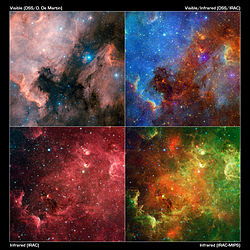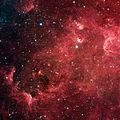- North America Nebula
-
North America Nebula 
This image layout reveals how the appearance of the North America nebula can change dramatically using different combinations of visible and infrared observations.Observation data: J2000.0 epoch Type Emission Right ascension 20h 59m 17.1s[1] Declination +44° 31′ 44″[1] Distance 1,600 ± 100 ly (675 ± 30 pc)[2] Apparent magnitude (V) 4 Apparent dimensions (V) 120 × 100 arcmins Constellation Cygnus Physical characteristics Radius - Absolute magnitude (V) - Notable features - Other designations NGC 7000, Sharpless 117, Caldwell 20 See also: Diffuse nebula, Lists of nebulae The North America Nebula (NGC 7000 or Caldwell 20) is an emission nebula in the constellation Cygnus, close to Deneb (the tail of the swan and its brightest star). The remarkable shape of the emission nebula resembles that of the continent of North America, complete with a prominent Gulf of Mexico. It is sometimes incorrectly called the "North American Nebula"[1].
Contents
General information
The North America Nebula is large, covering an area of more than four times the size of the full moon; but its surface brightness is low, so normally it cannot be seen with the unaided eye. Binoculars and telescopes with large fields of view (approximately 3°) will show it as a foggy patch of light under sufficiently dark skies. However, using a UHC filter, which filters out some unwanted wavelengths of light, it can be seen by the naked eye under dark skies. Its prominent shape and especially its reddish color (from the hydrogen Hα emission line) show up only in photographs of the area.
Cygnus's Wall is a term for the "Mexico and Central America part" of the North America Nebula. The Cygnus Wall exhibits the most concentrated star formations in the nebula.
The North America Nebula and the nearby Pelican Nebula, (IC 5070) are in fact parts of the same interstellar cloud of ionized hydrogen (H II region). Between the Earth and the nebula complex lies a band of interstellar dust that absorbs the light of stars and nebulae behind it, and thereby determines the shape as we see it. The distance of the nebula complex is not precisely known, nor is the star responsible for ionizing the hydrogen so that it emits light. If the star inducing the ionization is Deneb, as some sources say, the nebula complex would be about 1800 light years distance, and its absolute size (6° apparent diameter on the sky) would be 100 light years.
The nebula was discovered by William Herschel on October 24, 1786, from Slough, England.
-
Infrared view of the nebula.
-
The North America Nebula.
See also
References
- ^ a b "NASA/IPAC Extragalactic Database". Results for NGC 7000. http://nedwww.ipac.caltech.edu/. Retrieved 2006-10-17.
- ^ Shevchenko, V. S.; Grankin, K. N.; Nel'Nikov, S. Yu. (1988). "The structure of RSF 4 CYG B - Regions of star formation from an unusual point of view". Astronomicheskii Zhurnal (ISSN 0004-6299) 65: Nov.–Dec. 1988, p. 1230–1243. In Russian.. Bibcode 1988AZh....65.1230S.
Coordinates:
 20h 59m 18s, +44° 30′ 60″
20h 59m 18s, +44° 30′ 60″External links
- The North America Nebula (NGC 7000) at the astro-photography site of Mr. T. Yoshida.
- NASA APOD: The North America and Pelican Nebulae (June 30, 2009)
- NASA APOD: The North America Nebula (May 1, 2000)
- NASA APOD: The North America Nebula (June 6, 1996)
- NGC7000
- starpointing.com – Central part of the North America Nebula: The Great Wall]
- project-nightflight.net – DSLR image of the North America Nebula
- North America Nebula on WikiSky: DSS2, SDSS, GALEX, IRAS, Hydrogen α, X-Ray, Astrophoto, Sky Map, Articles and images
Sharpless catalog Sh2-1 · Sh2-2 · Sh2-3 · Sh2-4 · Sh2-5 · Sh2-6 · Sh2-7 · Sh2-8 · Sh2-9 · Sh2-10 · Sh2-11 · Sh2-12 · Sh2-13 · Sh2-14 · Sh2-15 · Sh2-16 · Sh2-17 · Sh2-18 · Sh2-19 · Sh2-20 · Sh2-21 · Sh2-22 · Sh2-23 · Sh2-24 · Sh2-25 · Sh2-26 · Sh2-27 · Sh2-28 · Sh2-29 · Sh2-30 · Sh2-31 · Sh2-32 · Sh2-33 · Sh2-34 · Sh2-35 · Sh2-36 · Sh2-37 · Sh2-38 · Sh2-39 · Sh2-40 · Sh2-41 · Sh2-42 · Sh2-43 · Sh2-44 · Sh2-45 · Sh2-46 · Sh2-47 · Sh2-48 · Sh2-49 · Sh2-50 · Sh2-51 · Sh2-52 · Sh2-53 · Sh2-54 · Sh2-55 · Sh2-56 · Sh2-57 · Sh2-58 · Sh2-59 · Sh2-60 · Sh2-61 · Sh2-62 · Sh2-63 · Sh2-64 · Sh2-65 · Sh2-66 · Sh2-67 · Sh2-68 · Sh2-69 · Sh2-70 · Sh2-71 · Sh2-72 · Sh2-73 · Sh2-74 · Sh2-75 · Sh2-76 · Sh2-77 · Sh2-78 · Sh2-79 · Sh2-80 · Sh2-81 · Sh2-82 · Sh2-83 · Sh2-84 · Sh2-85 · Sh2-86 · Sh2-87 · Sh2-88 · Sh2-89 · Sh2-90 · Sh2-91 · Sh2-92 · Sh2-93 · Sh2-94 · Sh2-95 · Sh2-96 · Sh2-97 · Sh2-98 · Sh2-99 · Sh2-100 · Sh2-101 · Sh2-102 · Sh2-103 · Sh2-104 · Sh2-105 · Sh2-106 · Sh2-107 · Sh2-108 · Sh2-109 · Sh2-110 · Sh2-111 · Sh2-112 · Sh2-113 · Sh2-114 · Sh2-115 · Sh2-116 · Sh2-117 · Sh2-118 · Sh2-119 · Sh2-120 · Sh2-121 · Sh2-122 · Sh2-123 · Sh2-124 · Sh2-125 · Sh2-126 · Sh2-127 · Sh2-128 · Sh2-129 · Sh2-130 · Sh2-131 · Sh2-132 · Sh2-133 · Sh2-134 · Sh2-135 · Sh2-136 · Sh2-137 · Sh2-138 · Sh2-139 · Sh2-140 · Sh2-141 · Sh2-142 · Sh2-143 · Sh2-144 · Sh2-145 · Sh2-146 · Sh2-147 · Sh2-148 · Sh2-149 · Sh2-150 · Sh2-151 · Sh2-152 · Sh2-153 · Sh2-154 · Sh2-155 · Sh2-156 · Sh2-157 · Sh2-158 · Sh2-159 · Sh2-160 · Sh2-161 · Sh2-162 · Sh2-163 · Sh2-164 · Sh2-165 · Sh2-166 · Sh2-167 · Sh2-168 · Sh2-169 · Sh2-170 · Sh2-171 · Sh2-172 · Sh2-173 · Sh2-174 · Sh2-175 · Sh2-176 · Sh2-177 · Sh2-178 · Sh2-179 · Sh2-180 · Sh2-181 · Sh2-182 · Sh2-183 · Sh2-184 · Sh2-185 · Sh2-186 · Sh2-187 · Sh2-188 · Sh2-189 · Sh2-190 · Sh2-191 · Sh2-192 · Sh2-193 · Sh2-194 · Sh2-195 · Sh2-196 · Sh2-197 · Sh2-198 · Sh2-199 · Sh2-201 · Sh2-202 · Sh2-203 · Sh2-204 · Sh2-205 · Sh2-206 · Sh2-207 · Sh2-208 · Sh2-209 · Sh2-210 · Sh2-211 · Sh2-212 · Sh2-213 · Sh2-214 · Sh2-215 · Sh2-216 · Sh2-217 · Sh2-218 · Sh2-219 · Sh2-220 · Sh2-221 · Sh2-222 · Sh2-223 · Sh2-224 · Sh2-225 · Sh2-226 · Sh2-227 · Sh2-228 · Sh2-229 · Sh2-230 · Sh2-231 · Sh2-232 · Sh2-233 · Sh2-234 · Sh2-235 · Sh2-236 · Sh2-237 · Sh2-238 · Sh2-239 · Sh2-240 · Sh2-241 · Sh2-242 · Sh2-243 · Sh2-244 · Sh2-245 · Sh2-246 · Sh2-247 · Sh2-248 · Sh2-249 · Sh2-250 · Sh2-251 · Sh2-252 · Sh2-253 · Sh2-254 · Sh2-255 · Sh2-256 · Sh2-257 · Sh2-258 · Sh2-259 · Sh2-260 · Sh2-261 · Sh2-262 · Sh2-263 · Sh2-264 · Sh2-265 · Sh2-266 · Sh2-267 · Sh2-268 · Sh2-269 · Sh2-270 · Sh2-271 · Sh2-272 · Sh2-273 · Sh2-274 · Sh2-275 · Sh2-276 · Sh2-277 · Sh2-278 · Sh2-279 · Sh2-280 · Sh2-281 · Sh2-282 · Sh2-283 · Sh2-284 · Sh2-285 · Sh2-286 · Sh2-287 · Sh2-288 · Sh2-289 · Sh2-290 · Sh2-291 · Sh2-292 · Sh2-293 · Sh2-294 · Sh2-295 · Sh2-296 · Sh2-297 · Sh2-298 · Sh2-299 · Sh2-301 · Sh2-302 · Sh2-303 · Sh2-304 · Sh2-305 · Sh2-306 · Sh2-307 · Sh2-308 · Sh2-309 · Sh2-310 · Sh2-311 · Sh2-312 · Sh2-313
The Caldwell catalogue List C1 · C2 · C3 · C4 · C5 · C6 · C7 · C8 · C9 · C10 · C11 · C12 · C13 · C14 · C15 · C16 · C17 · C18 · C19 · C20 · C21 · C22 · C23 · C24 · C25 · C26 · C27 · C28 · C29 · C30 · C31 · C32 · C33 · C34 · C35 · C36 · C37 · C38 · C39 · C40 · C41 · C42 · C43 · C44 · C45 · C46 · C47 · C48 · C49 · C50 · C51 · C52 · C53 · C54 · C55 · C56 · C57 · C58 · C59 · C60 · C61 · C62 · C63 · C64 · C65 · C66 · C67 · C68 · C69 · C70 · C71 · C72 · C73 · C74 · C75 · C76 · C77 · C78 · C79 · C80 · C81 · C82 · C83 · C84 · C85 · C86 · C87 · C88 · C89 · C90 · C91 · C92 · C93 · C94 · C95 · C96 · C97 · C98 · C99 · C100 · C101 · C102 · C103 · C104 · C105 · C106 · C107 · C108 · C109See also Categories:- Cygnus constellation
- H II regions
- NGC objects
- Caldwell objects
Wikimedia Foundation. 2010.



